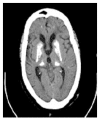From variome to phenome: Pathogenesis, diagnosis and management of ectopic mineralization disorders
- PMID: 26244149
- PMCID: PMC4517332
- DOI: 10.12998/wjcc.v3.i7.556
From variome to phenome: Pathogenesis, diagnosis and management of ectopic mineralization disorders
Abstract
Ectopic mineralization - inappropriate biomineralization in soft tissues - is a frequent finding in physiological aging processes and several common disorders, which can be associated with significant morbidity and mortality. Further, pathologic mineralization is seen in several rare genetic disorders, which often present life-threatening phenotypes. These disorders are classified based on the mechanisms through which the mineralization occurs: metastatic or dystrophic calcification or ectopic ossification. Underlying mechanisms have been extensively studied, which resulted in several hypotheses regarding the etiology of mineralization in the extracellular matrix of soft tissue. These hypotheses include intracellular and extracellular mechanisms, such as the formation of matrix vesicles, aberrant osteogenic and chondrogenic signaling, apoptosis and oxidative stress. Though coherence between the different findings is not always clear, current insights have led to improvement of the diagnosis and management of ectopic mineralization patients, thus translating pathogenetic knowledge (variome) to the phenotype (phenome). In this review, we will focus on the clinical presentation, pathogenesis and management of primary genetic soft tissue mineralization disorders. As examples of dystrophic calcification disorders Pseudoxanthoma elasticum, Generalized arterial calcification of infancy, Keutel syndrome, Idiopathic basal ganglia calcification and Arterial calcification due to CD73 (NT5E) deficiency will be discussed. Hyperphosphatemic familial tumoral calcinosis will be reviewed as an example of mineralization disorders caused by metastatic calcification.
Keywords: Arterial calcification due to CD73 deficiency; Ectopic mineralization; Etiology; Generalized arterial calcification of infancy; Hyperphosphatemic familial tumoral calcinosis; Idiopathic basal ganglia calcification; Keutel syndrome; Phenotype; Pseudoxanthoma elasticum; Pseudoxanthoma elasticum-like syndrome.
Figures




Similar articles
-
Therapeutics Development for Pseudoxanthoma Elasticum and Related Ectopic Mineralization Disorders: Update 2020.J Clin Med. 2020 Dec 31;10(1):114. doi: 10.3390/jcm10010114. J Clin Med. 2020. PMID: 33396306 Free PMC article. Review.
-
Pseudoxanthoma Elasticum as a Paradigm of Heritable Ectopic Mineralization Disorders: Pathomechanisms and Treatment Development.Am J Pathol. 2019 Feb;189(2):216-225. doi: 10.1016/j.ajpath.2018.09.014. Epub 2018 Nov 7. Am J Pathol. 2019. PMID: 30414410 Free PMC article. Review.
-
Inherited Arterial Calcification Syndromes: Etiologies and Treatment Concepts.Curr Osteoporos Rep. 2017 Aug;15(4):255-270. doi: 10.1007/s11914-017-0370-3. Curr Osteoporos Rep. 2017. PMID: 28585220 Review.
-
Mineralization/anti-mineralization networks in the skin and vascular connective tissues.Am J Pathol. 2013 Jul;183(1):10-8. doi: 10.1016/j.ajpath.2013.03.002. Epub 2013 May 8. Am J Pathol. 2013. PMID: 23665350 Free PMC article. Review.
-
Ectopic mineralization disorders of the extracellular matrix of connective tissue: molecular genetics and pathomechanisms of aberrant calcification.Matrix Biol. 2014 Jan;33:23-8. doi: 10.1016/j.matbio.2013.06.003. Epub 2013 Jul 25. Matrix Biol. 2014. PMID: 23891698 Free PMC article. Review.
Cited by
-
ABCC6 Involvement in Cerebral Small Vessel Disease: Potential Mechanisms and Associations.Genes (Basel). 2025 Jun 23;16(7):728. doi: 10.3390/genes16070728. Genes (Basel). 2025. PMID: 40725385 Free PMC article. Review.
-
Mitochondrial Dysfunction and Oxidative Stress in Hereditary Ectopic Calcification Diseases.Int J Mol Sci. 2022 Dec 4;23(23):15288. doi: 10.3390/ijms232315288. Int J Mol Sci. 2022. PMID: 36499615 Free PMC article. Review.
-
Minocycline Counteracts Ectopic Calcification in a Murine Model of Pseudoxanthoma Elasticum: A Proof-of-Concept Study.Int J Mol Sci. 2022 Feb 6;23(3):1838. doi: 10.3390/ijms23031838. Int J Mol Sci. 2022. PMID: 35163765 Free PMC article.
-
Autofluorescence Imaging of the Skin Is an Objective Non-Invasive Technique for Diagnosing Pseudoxanthoma Elasticum.Diagnostics (Basel). 2021 Feb 8;11(2):260. doi: 10.3390/diagnostics11020260. Diagnostics (Basel). 2021. PMID: 33567497 Free PMC article.
-
New Therapeutics Targeting Arterial Media Calcification: Friend or Foe for Bone Mineralization?Metabolites. 2022 Apr 5;12(4):327. doi: 10.3390/metabo12040327. Metabolites. 2022. PMID: 35448514 Free PMC article. Review.
References
-
- Vanakker O, Hosen MJ, De Paepe A. Ectopic soft tissue calcification: process, determinants and health impact. Hauppauge, NY: Human Anatomy and Physiology; 2013. pp. 261–304.
-
- Kirsch T. Biomineralization--an active or passive process? Connect Tissue Res. 2012;53:438–445. - PubMed
-
- Kornak U. Animal models with pathological mineralization phenotypes. Joint Bone Spine. 2011;78:561–567. - PubMed
Publication types
LinkOut - more resources
Full Text Sources
Other Literature Sources
Research Materials
Miscellaneous

